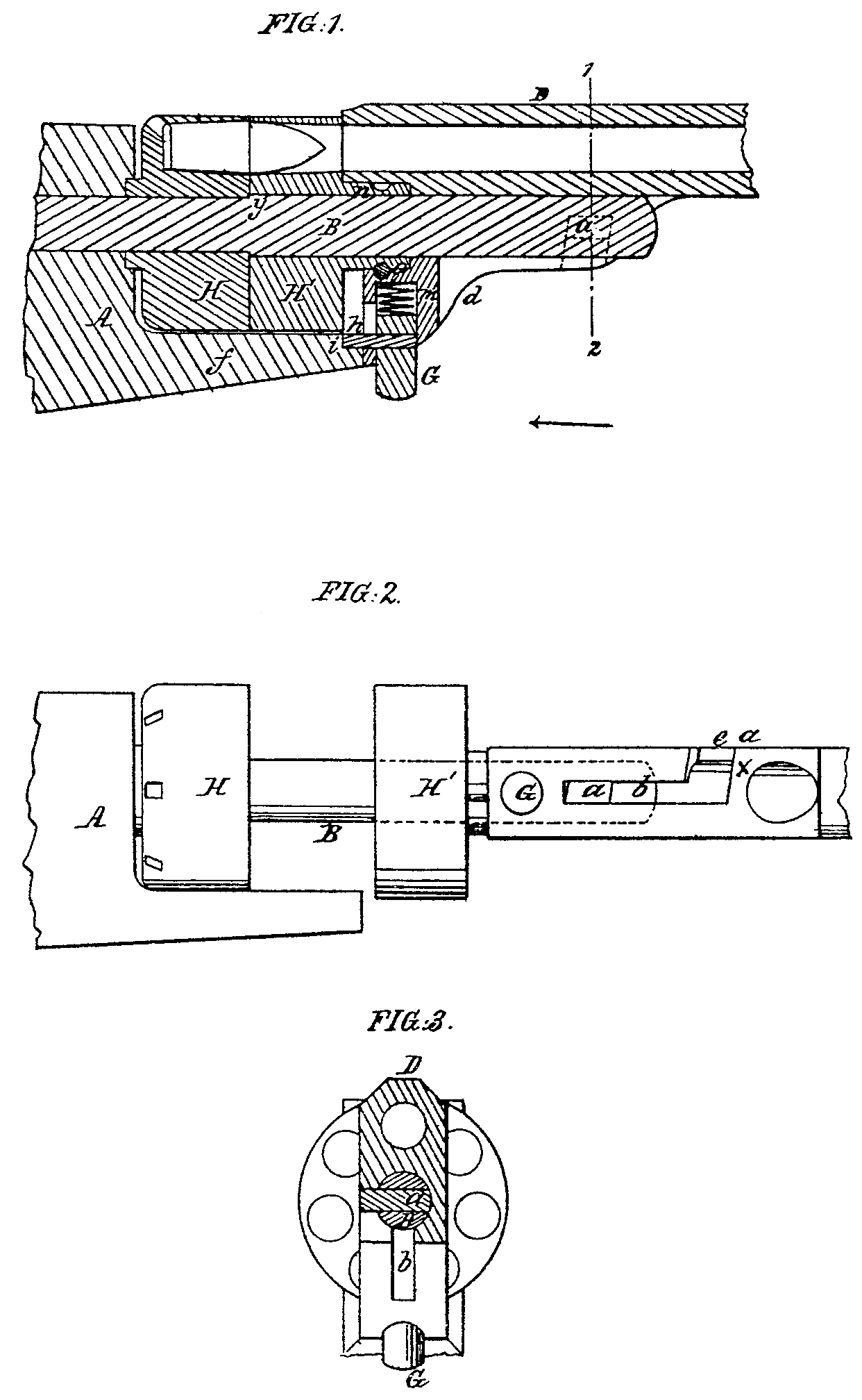US 51836
UNITED STATES PATENT OFFICE.
BENJAMIN F. JOSLYN, OF STONINGTON, CONNECTICUT.
IMPROVEMENT IN REVOLVING FIRE-ARMS.
Specification forming part of Letters Patent No. 51,836, dated January 2, 1866; antedated December 26, 1865.
To all whom it may concern:
Be it known that I, B. F. Joslyn, of Stonington, Connecticut, have invented certain Improvements in Revolving Fire-Arms; and I do hereby declare the following to be a full, clear, and exact description of the same, reference being had to the accompanying drawings, and to the letters of reference marked thereon.
My invention consists in the peculiar mode, fully described hereinafter, of connecting the barrel to the frame of a revolver; and my invention further consists of a device, described hereinafter, for retaining the barrel in its position in relation to the frame.
In order to enable others skilled in the art to make and use my invention, I will now proceed to describe its construction and operation.
On reference to the accompanying drawings, which form a part of this specification, Figure 1 is a longitudinal section of part of a revolving fire-arm made in accordance with my improvement; Fig. 2, a side view of the same, showing the barrel as moved away from the frame; and Fig. 3, a transverse section on the line 1 2, Fig. 1.
Similar letters refer to similar parts through out the several views.
A represents part of the frame of the revolver, to which is secured the breech-pin B, the latter passing through a projection, d, on the under side and at the rear end of the barrel D, and the pin being provided, near its outer end, with an oblong projection, a, Fig.2, adapted to a groove, b, formed in the under side of the projection d of the barrel, and to a recess, e, cut in one side of the said projection, and communicating with the said groove b, as clearly shown in Fig.2. A block, G, fits snugly in a chamber formed in the under side of the barrel, a spring, m, intervening between the end of the recess and the block, and tending to force the latter outward, and to maintain a pin, h, projecting from the block in a recess, i, cut in the end of a projection, f, of the frame A.
As seen in Fig. 1, the barrel is firmly locked to the frame through the medium of the breech-pin, owing to the oblong projection a of the latter occupying a position in the recess e on the side of the projection d of the barrel. (See Fig. 2.)
On pressing the block G until its pin h is clear of the projection f of the frame, the barrel is at liberty to be turned laterally until its groove b is in line with the projection a of the breech-pin, when the barrel can be moved forward along the latter to the position shown in Fig. 2. The cartridges may now be introduced into the cylinder, after which the barrel is moved back until the outer edge, x, of the recess e strikes the projection a, when the barrel is turned laterally to its former position, the projection a taking its place in the recess e, as before, and the pin h of the spring-block G fitting into the recess i of the projection f of the frame, to which the barrel is now firmly locked.
It will be observed that the recess e and projections a are so inclined that on turning the barrel for the purpose of locking it to the frame it will complete its movement toward the latter. Two or more of these projections, a, may be used on the barrel, there being a corresponding number of inclined recesses e in the frame.
In the present instance I have shown a cylinder composed of two portions, H and H’, the former of which is confined to the frame by a collar, y, on the breech-pin, the portion H’ having a tubular projection, n, fitting and arranged to turn in the projection d of the barrel, to which it is confined by a pin, q.
When the barrel has been moved to the position shown in Fig. 2 the portion H’ of the cylinder has been removed so far away from the portion H that the peculiarly-formed cartridges shown in Fig.1 can be readily inserted in the chambers of the latter portion of the cylinder.
I wish it to be understood, however, that I have no desire to claim a cylinder of the peculiar construction represented and described, nor do I desire to confine myself to a cylinder of any specific construction; but
I claim as my invention and desire to secure by Letters Patent—
1. Connecting the frame and barrel of a revolver together by means of a center-pin, B, secured to the frame, and having one or more projections, a, adapted to a groove, b, and to one or more inclined recesses, e, of the barrel, all substantially as and for the purpose herein set forth.
2. The combination of the barrel, its spring-block G, and pin h with the projection f of the frame and its recess i.
In testimony whereof I have signed my lane to this specification in the presence of two subscribing witnesses.
B. F. JOSLYN.
Witnesses:
Charles E. Foster,
John White.

